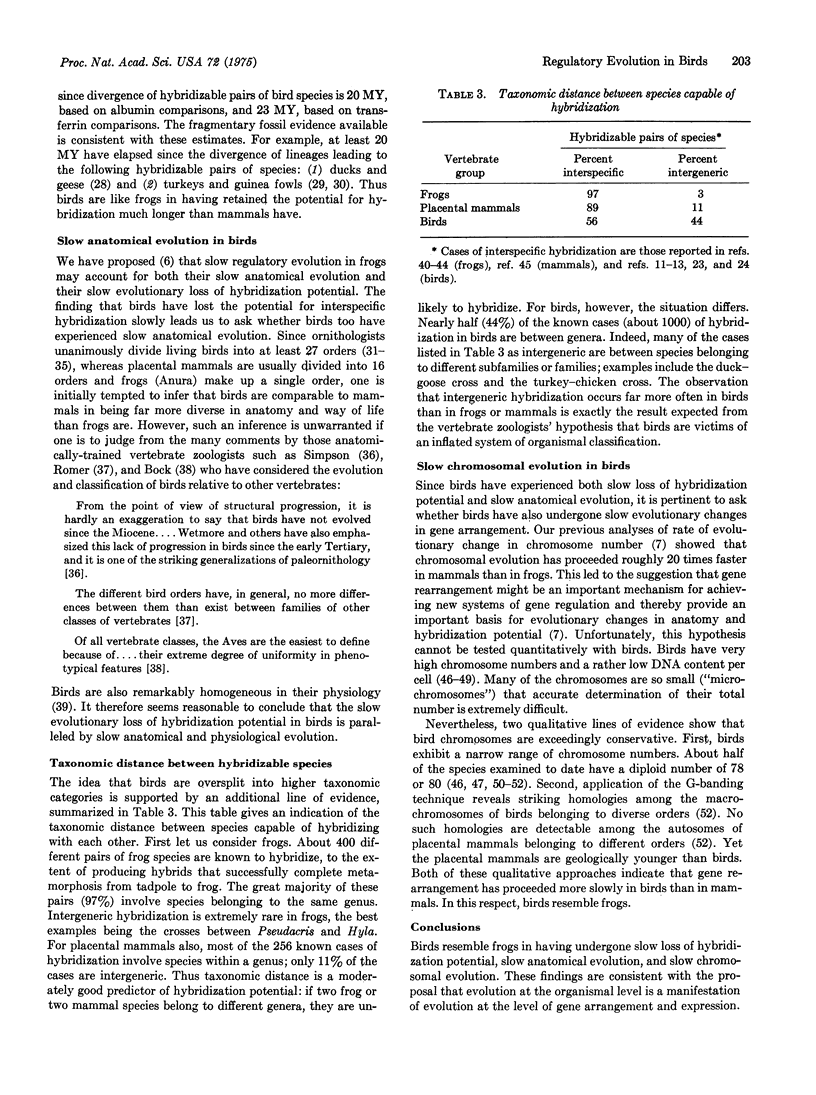Abstract
Birds have lost the potential for interspecific hybridization slowly. This inference emerges from protein comparisons made on 36 pairs of bird species capable of hybridization. Micro-complement fixation tests show that hybridizable pairs of bird species differ by an average of 12 units of albumin immunological distance and 25 units of transferrin immunological distance. As these proteins evolve at a known and rather steady rate, it is inferred that the average hybridization species pair diverged from a common ancestor about 22 million years ago. The corresponding period for frog species pairs capable of hybridization is about 21 million years, while for hybridizable placental mammals it is only 2 to 3 million years. Thus birds resemble frogs in having lost the potential for interspecific hybridization about 10 times as slowly as have mammals. Birds have also been evolving very slowly at the anatomical level, particularly within the last 25 million years, according to Simpson, Romer, and many other vertebrate zoologists. In this respect they resemble frogs and differ from placental mammals, which have been undergoing unusually rapid anatomical evolution. Chromosomal evolution is also thought to have proceeded very slowly in both birds and frogs, relative to mammals. The above observations are consistent with the hypothesis that evolutionary changes in regulatory systems, that is, changes in the patterns of gene expression, provide the basis for both anatomical evolution and the evolutionary loss of hybridization potential.
Full text
PDF




Selected References
These references are in PubMed. This may not be the complete list of references from this article.
- Bakay B., Nyhan W. L. An improved technique for the separation of glucose 6-phosphate dehydrogenase isoenzymes by disc electrophoresis on polyacrylamide gel. Biochem Genet. 1969 Dec;3(6):571–582. doi: 10.1007/BF00485478. [DOI] [PubMed] [Google Scholar]
- Blackler A. W., Gecking C. A. Transmission of sex cells of one species through the body of a second species in the genus Xenopus. II. Interspecific matings. Dev Biol. 1972 Mar;27(3):385–394. doi: 10.1016/0012-1606(72)90177-7. [DOI] [PubMed] [Google Scholar]
- Bloom S. E. A current list of chromosome numbers and variations for species of the avian subclass Carinatae. J Hered. 1969 Jul-Aug;60(4):217–220. doi: 10.1093/oxfordjournals.jhered.a107975. [DOI] [PubMed] [Google Scholar]
- Britten R. J., Davidson E. H. Repetitive and non-repetitive DNA sequences and a speculation on the origins of evolutionary novelty. Q Rev Biol. 1971 Jun;46(2):111–138. doi: 10.1086/406830. [DOI] [PubMed] [Google Scholar]
- Davidson E. H., Britten R. J. Organization, transcription, and regulation in the animal genome. Q Rev Biol. 1973 Dec;48(4):565–613. doi: 10.1086/407817. [DOI] [PubMed] [Google Scholar]
- Haley L. E., Abplanalp H. Possible immunological basis for a reduction of fertility in cross-mating fowl with Japanese quail. J Reprod Fertil. 1970 Dec;23(3):375–381. doi: 10.1530/jrf.0.0230375. [DOI] [PubMed] [Google Scholar]
- Hartman B. K., Udenfriend S. A method for immediate visualization of proteins in acrylamide gels and its use for preparation of antibodies to enzymes. Anal Biochem. 1969 Sep;30(3):391–394. doi: 10.1016/0003-2697(69)90132-8. [DOI] [PubMed] [Google Scholar]
- MOORE J. A. Abnormal combinations of nuclear and cytoplasmic systems in frogs and toads. Adv Genet. 1955;7:139–182. doi: 10.1016/s0065-2660(08)60095-4. [DOI] [PubMed] [Google Scholar]
- Ono S. Ancient linkage groups and frozen accidents. Nature. 1973 Aug 3;244(5414):259–262. doi: 10.1038/244259a0. [DOI] [PubMed] [Google Scholar]
- Prager E. M., Brush A. H., Nolan R. A., Nakanishi M., Wilson A. C. Slow evolution of transferrin and albumin in birds according to micro-complement fixation analysis. J Mol Evol. 1974;3(4):243–262. doi: 10.1007/BF01796041. [DOI] [PubMed] [Google Scholar]
- Prager E. M., Wilson A. C. The dependence of immunological cross-reactivity upon sequence resemblance among lysozymes. I. Micro-complement fixation studies. J Biol Chem. 1971 Oct 10;246(19):5978–5989. [PubMed] [Google Scholar]
- Prager E. M., Wilson A. C. The dependence of immunological cross-reactivity upon sequence resemblance among lysozymes. II. Comparison of precipitin and micro-complement fixation results. J Biol Chem. 1971 Nov 25;246(22):7010–7017. [PubMed] [Google Scholar]
- Sarich V. M. On the nonidentity of several carnivore hemoglobins. Biochem Genet. 1972 Dec;7(3):253–258. doi: 10.1007/BF00484824. [DOI] [PubMed] [Google Scholar]
- Sarich V. M. Pinniped origins and the rate of evolution of carnivore albumins. Syst Zool. 1969 Sep;18(3):286–295. [PubMed] [Google Scholar]
- Stratil A., Spooner R. L. Isolation and properties of individual components of cattle transferrin: the role of sialic acid. Biochem Genet. 1971 Aug;5(4):347–365. doi: 10.1007/BF00485861. [DOI] [PubMed] [Google Scholar]
- Takagi N., Sasaki M. A phylogenetic study of bird karyotypes. Chromosoma. 1974 May 21;46(1):91–120. doi: 10.1007/BF00332341. [DOI] [PubMed] [Google Scholar]
- Wallace B., Kass T. L. On the structure of gene control regions. Genetics. 1974 Jul;77(3):541–558. doi: 10.1093/genetics/77.3.541. [DOI] [PMC free article] [PubMed] [Google Scholar]
- Wallace D. G., Maxson L. R., Wilson A. C. Albumin evolution in frogs: a test of the evolutionary clock hypothesis. Proc Natl Acad Sci U S A. 1971 Dec;68(12):3127–3129. doi: 10.1073/pnas.68.12.3127. [DOI] [PMC free article] [PubMed] [Google Scholar]
- Wallace D. G., Wilson A. C. Comparison of frog albumins with those of other vertebrates. J Mol Evol. 1972 Dec 29;2(1):72–86. doi: 10.1007/BF01653944. [DOI] [PubMed] [Google Scholar]
- Wilson A. C., Maxson L. R., Sarich V. M. Two types of molecular evolution. Evidence from studies of interspecific hybridization. Proc Natl Acad Sci U S A. 1974 Jul;71(7):2843–2847. doi: 10.1073/pnas.71.7.2843. [DOI] [PMC free article] [PubMed] [Google Scholar]
- Wilson A. C., Sarich V. M., Maxson L. R. The importance of gene rearrangement in evolution: evidence from studies on rates of chromosomal, protein, and anatomical evolution. Proc Natl Acad Sci U S A. 1974 Aug;71(8):3028–3030. doi: 10.1073/pnas.71.8.3028. [DOI] [PMC free article] [PubMed] [Google Scholar]


